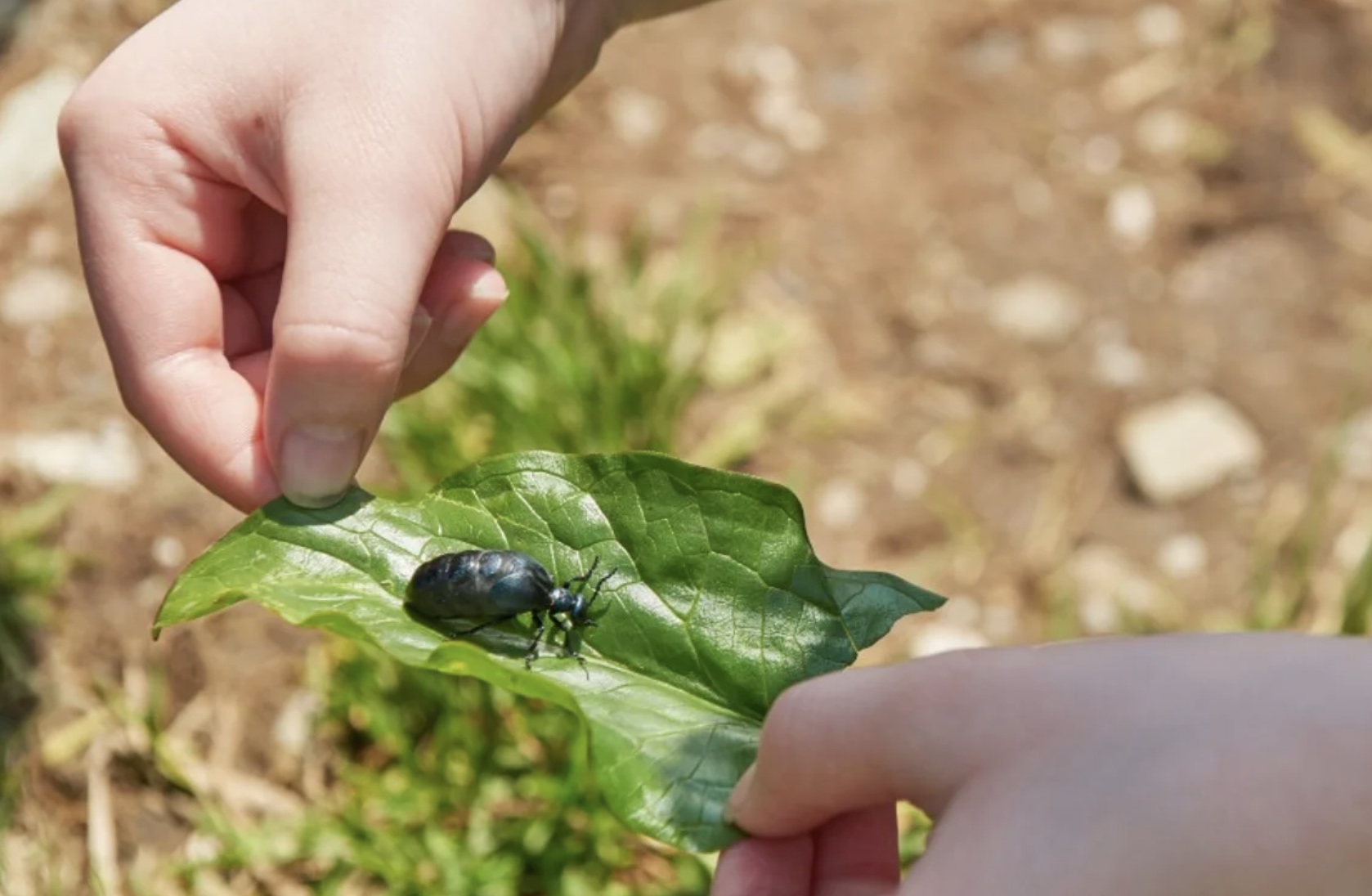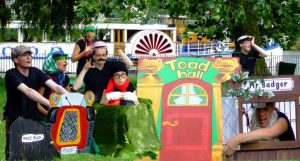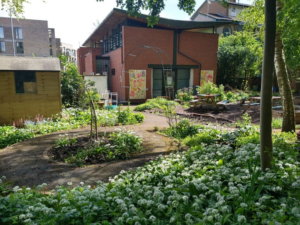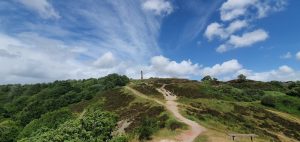Wildlife activities are a great way to emphasise the wildlife in parks, to involve young people and adults and to educate people about the environment so they appreciate and respect it. The site may have a habitat, a species or even several of both that can be promoted to the public, or perhaps it is issues such as climate change that affect the biodiversity of parks/green spaces that need to be highlighted. In each case wildlife activities may be the way to do so.
There are some activities such as mini beast hunts and nature walks that are quite popular and are widely used at nature reserves, school outings and park events. These are easy to run and very enjoyable. See the National Trust’s website and the Wildlife Trust has an information pack and spotters sheet.
Organisation
Once it is known what activities are going to happen at the event and what they involve it is important to fill out a risk assessment. Before doing this you need to choose what parts of the site you are going to use and assess its suitability. Consider what age groups will be involved in the activity when filling in the risk assessment.
It is also important to consider the participants age when designing the activity, the approach may vary with different age groups. Be flexible and prepared to adjust the level of the activity to the ability of the group. Also be prepared to include adults in the activities.
Consider what issues and points you would like to get across in the activity, ask questions to find out what the group already know and then consider how to develop their knowledge.
When deciding on group size, consider the age range of the participants and how many people are available to lead the activity. It also depends on the ability of the leader. It is recommended to have a leader participant ratio of 1:6, especially when working with children if their parent/guardians are not present.
If the activity leader is the only adult running the activity in the absence of a parent/guardian then they need to be CRB (Criminal Records Bureau) checked. For safety when advertising the activity, it is advisable to state that children can only take part if their parent/guardian/responsible adult is present; in this case there is no need for a CRB check on the activity leader but you may consider having one anyway.
Preparation
Prepare all the equipment a few weeks prior to the event. If preparing for activities such as a minibeast hunt or pond dipping the local authority may be able to provide some equipment and expertise. It may be worth investing in some equipment if planning to make it a regular event. The following websites stock this type of equipment:
- www.nhbs.com (NB This was Alana Ecology)
- www.uksafari.com
These websites are useful for identification charts and guides:
If involved in the activity but unfamiliar in identifying species, it is advisable to do a trial of the wildlife activity first to identify the species using identification guides. You could also contact a local expert or knowledgeable amateur to assist in developing these skills – they may even be willing to help out on the day. There are also courses that may be useful.
Don’t be afraid to admit that you don’t know what something is during the activity. If you can’t identify it, encourage the participants to investigate further when they get home on the internet. Try and take a photo of the species.
Here are some useful website to identify plants and invertebrates:
Health and Safety
The Risk Assessment should be in place at least a month before the event.
Be aware of any allergies or medical issues in the group. As the activity will most likely be a case of participants turning up on the day rather than signing up beforehand, ask the group and their guardians if there are any medical issues or allergies that the activity leader should be made aware of. Consider if the activity may adversely affect them and take any safety precautions to avoid conditions that may affect them.
If working in freshwater, advise anyone with open cuts or sores not to go in the water. This is a safety precaution against contacting Weil’s disease, a bacterial infection carried by rats. When working in long grass or shrubs, advise participants to wear long sleeved tops and trousers tucked into their socks or boots if possible, to avoid cuts, scrapes and ticks attaching to the skin which can in some cases cause Lyme’s Disease, another bacterial infection.
Provide hand washing facilities if the participants have been handling animals and plants and exploring different habitats. Advise participants to be careful when handling animals and plants, pointing out any biting and stinging animals or thorny plants.
Don’t kill any animals on purpose and don’t pick any rare or uncommon plants.
How to run a mini beast hunt
Description
This activity involves searching for invertebrates such as spiders, beetles, millipedes, snails, etc., and identifying them
Equipment
White trays, pooters, magnijars, identification charts, pitfall traps, trowel
Preparation
Choose an area of the site that has plenty of vegetation such as a meadow, a coppice, a thick hedgerow, etc. Once the location of the activity is decided, it is a good idea to create a log pile if possible. This can be done a few weeks before the activity to encourage invertebrates to the area and even sometimes amphibians such as newts. To make a log pile, gather logs, branches and twigs, pile them on top of each other and scatter leaves and soil on top and then wait and see what makes it their home.
On the morning of the event, a couple of hours before the activity begins, lay pitfall traps. Pitfall traps are simple and easy to make and almost guaranteed to catch some kind of invertebrate. Dig a hole with the trowel in the ground to put in a used yoghurt pot or plastic cup. Make sure the top of the cup is level with the soil surface and fill in any gaps around the edge with soil. Place a piece of apple or other goodie in the cup to attract the invertebrates. Lay several of these pitfall traps in different vegetation around the area of the site. It is a good idea to mark on a map of the site the position of each pitfall trap. Count exactly how many you have laid so they can be checked before leaving site.
Demonstrate the Equipment
- White trays – for examining invertebrates once caught.
- Pooters – a device to suck up small invertebrates into a jar. Take care to make sure the animal you are sucking up is no bigger than the opening of the tube. Do not use this device on worms, slugs or snails.
- Magnijar – a container that has a magnified lid to allow a closer view of the specimen.
- Identification charts – a step by step guide to assist in the identification of invertebrates.
Method
At the start of the mini beast hunt, run through any health and safety issues with the assembled group. If necessary divide the group and assign an leader to each group.
Firstly find the pitfall traps that were laid previously. Give young people hints on where they are and see if they can find them. Empty the invertebrates into a white tray and help the participants to identify them. This will give them an idea of what they will be looking for.
Once the equipment has been demonstrated divide the equipment between pairs of participants and describe their geographical boundaries. Then start looking. Look in the log pile by carefully picking up the logs and looking under the bark. Look between the grass and other vegetation, on tree trunks, in leaf litter and on walls. Advise the participants not to kill anything they find.
To make it more fun and challenging devise a points system. Designate the rarer species with higher points and whoever gets the most points wins.
Help the participants to release all the species that have been caught and advise them to wash their hands. Do a question and answer session afterwards and see how many species they can remember.
Before leaving the site, check all pitfall traps are empty and remove, filling in holes.
Pond Dipping activities are covered here.
Other activity examples
Making log piles
As described previously in the preparation for the mini beast hunt, making log piles can also be an activity in itself which the community can become involved with on the day. In a few weeks or months they can check to see what is living in them. The log pile will become an ongoing place of interest in the park/green space.
Making bird boxes and insect boxes
Wildlife and conservation organisations are often keen to come to events and run this task with the public. These organisations may have easy access to the tools and wood needed for this task and may also provide supervision and run demonstrations. Contact the local branch of the TCV and the RSPB to see if they would be interested in running this activity.
Safari
A wildlife safari in a UK park is quite like a guided nature tour but you can incorporate several small activities into it. If the safari is themed on one particular aspect of nature on the site, this can allow more depth on a subject and development of interesting activities. For instance theming the activity around trees can incorporate:
- Taking bark rubbings from different trees
- Identifying different leaves and buds
- Looking at trees in different life stages
- The management of trees
- Making arts and crafts from trees
Visit www.naturedetectives.org.uk for more ideas.
There is also a site called www.rECOrd-lrc.co.uk which has lots of games with an environmental theme which you can use.
Bird watching
The diversity of birds in a park may depend on the time of year. A local keen birdwatcher may be quite willing to be involved in pointing out different species to the public. The RSPB or BTO (British Trust for Ornithology) may also like to be involved and run an activity to help promote their organisation. This activity can be done by setting up a good viewing point for birds, such as by a lake or a thick hedgerow.
Fossil Hunt
Some sites may allow for this activity depending on their geology and management. The following website gives details on the safety code to follow when collecting fossils:
Microscope
This activity requires some expensive equipment and expertise but with a little research, individuals or an organisation may offer to run such an activity. This would perhaps follow a minibeast hunt or a pond dipping session, allowing people to look at the invertebrates and plants they may have found under a microscope. Aquatic invertebrates are easier to view under a microscope in a little water as they are less likely to crawl away. On the other hand the activity organiser could bring along invertebrates and plant material they have already collected. This activity can take place even if it rains as it needs to have suitable cover such as a marquee or gazebo to protect the equipment.
Petting farm/birds of prey displays
There are several companies which run petting farms/birds of prey displays and they are often interested in attending park/green space events as they will generally have donation boxes. This is a nice way for people to get close to animals. There is a general cost involved and a need to supply hand wash/wipes.
Bulb Planting/Tree Planting
Depending on the time of year, bulb planting/tree planting in the park/green space is a great way for the local community to get involved in practical work in their park/green space. The local park rangers may appreciate the community giving them a hand with their tasks and gardeners could be involved in leading this activity.
Games
Squirrel Hide and Seek
(Taken from “Woodlands 2004”, produced by Wildlife Watch and written by Jane De’Ath and Anne Heaton)
Squirrels are probably one of the best known woodland mammals and their daring can amaze children. Squirrels spend more time asleep in the winter than at other times of the year, waking to search out food they have buried the autumn before. Scientists are split as to whether the food they find is in a specific place where they remembered burying it or whether they are just lucky in their foraging. Either way squirrels are very good seed dispersers as they never collect up all the seed they bury.
Equipment
You will need enough acorns, conkers, hazelnuts for each member of your group to have three nuts in total.
Method
Give out the nuts. Allow 30 seconds for them to hide each of their nuts in different places. Continue with other different activities. At the end of your session allow 30/60 seconds for the children to find their hidden nuts. Timing is important. Some children will only find one or two nuts; some may even acquire someone else’s nuts. Explain how squirrels aid seed dispersal by forgetting where they hid their nuts and point out that is often a trade-off between being able to find the nuts they hid and hiding them well enough so other animals don’t find them.
Scavenger Hunt
(Taken from “Woodlands 2004” as above)
Equipment
You will need a list of scavenger items and a small bag or box for each child/group.
Method
This is particularly good during autumn or winter when there are lots of treasures to find on the ground. Give each child a bag or box and the scavenger hunt list. Set the geographical boundaries they can cover and the time they have to find the items. See how many of the items they can find on their list. Scavenger ideas might be:
- Something shiny
- A chewed leaf
- A seed with wings
- Something rough
- A nibbled nut
- A symmetrical leaf
- A feather
- A manmade object
- A long leaf
- Something prickly
- A smile
Who Am I?
(Taken from “Freshwater 2004”, produced by Wildlife Watch and written by Jane De’Ath and Anne Heaton)
Equipment
You will need pens or pencils, card, sticky tape.
Method
After the children have been pond dipping or on a mini beast ask each child to choose an animal. They can pick birds, insects, fish, mammals, arachnids and amphibians, etc. Ask each child to draw their animal on a piece of card. Underneath the picture they need to put all or some of the following information: the animal’s name; where it is found; whether it is soft or hard bodied; how it moves; how many legs it has; its size; how it breathes; how it feeds.
Once they have finished, mix up the cards and tape one on each child’s back. In pairs the children take turns to question each other to try and discover what they are. Only yes or no answers are allowed. Questions such as Do I live underwater. Do I have six legs? Do I have a bony skeleton? Have I got feathers?
Eventually the children will guess their own identity. Once all the children have discovered their identities, if the group is large enough, you can help them sort themselves into herbivores and carnivores. Get the children to build up a food web, linking them with wool. Ask the children what will happen if an animal near the bottom of the food chain disappears or absorbs some poison. Get them to trace the effects through all the links. They should see that the whole web would ultimately be affected.
What to do if it rains
Depending on how well prepared the participants are for the mini beast activity and their willingness to do the activity in the rain, you may be able to continue with the activity but be aware of the participants getting too cold or wet. If the participants will not go out in the rain and are sheltering in a marquee, the activity leader could find some invertebrates and bring them back to the group for them to identify.
Most of the other activities will be able to continue as long as all the participants are dressed in appropriate clothing. However if it is continuous rain it may not be so enjoyable. It is then a judgement call based on the weather forecast and the enthusiasm of the group. The Who Am I game can be played indoors and is a way to occupy children while the rain eases off.
Other organisations
- The Conservation Volunteers (TCV) Tel: 01302 388 883 www.tcv.org.uk
- British Trust for Ornithology (BTO) Tel: 01842 750050 www.bto.org
- Buglife Tel: 01733 201 210 www.buglife.org.uk
- Butterfly Conservation Tel: 01929 400209 www.butterfly-conservation.org
- Field Studies Council Tel: 0845 345071 www.field-studies-council.org
- Forestry Commission Tel: 0845 367 3787 www.forestry.gov.uk
- Froglife Tel: 01733 558960 www.froglife.org
- Natural England Tel: 0114 241 8920 www.naturalengland.org.uk
- Royal Society for the Protection of Birds (RSPB) Tel: 01767 693 690 www.rspb.org.uk
- Pond Conservation Trust now The Freshwater Habitats Trust
- British Hedgehog Preservation Society www.britishhedgehogs.org.uk
- The Environment Agency Tel: 08708 506 506 www.environment-agency.gov.uk
- The Mammal Society www.mammal.org.uk
- The Woodland Trust www.woodland-trust.org.uk
- Wildlife Trust Tel: 01636 677711 www.wildlifetrusts.org
- Freshwater Habitats Trust www.freshwaterhabitats.org.uk
- The Amphibian and Reptile Conservation Trust www.ar-trust.org.uk

Reproduced with permission of North West Parks Friends Forum







